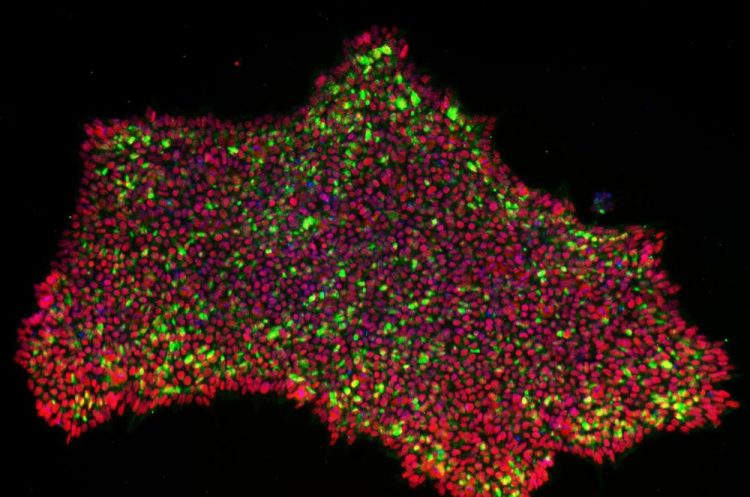Researchers develop a new method for turning skin cells into pluripotent stem cells

CRISPRa reprogrammed induced pluripotent stem cell colonies stained for pluripotency marker expression. Credit: Otonkoski Lab / University of Helsinki
Up till now, reprogramming has only been possible by introducing the critical genes for the conversion, called Yamanaka factors, artificially into skin cells where they are not normally active at all.
Professor Timo Otonkoski at the University of Helsinki and Professor Juha Kere at Karolinska Institutet and King's College London, with their teams of researchers, have now for the first time succeeded in converting skin cells into pluripotent stem cells by activating the cell's own genes.
This was achieved by using gene editing technology – called CRISPRa – that can be directed to activate genes. The method utilizes a blunted version of the Cas9 'gene scissors' that does not cut DNA and can therefore be used to activate gene expression without mutating the genome.
“CRISPR/Cas9 can be used to activate genes. This is an attractive possibility for cellular reprogramming because multiple genes can be targeted at the same time. Reprogramming based on activation of endogenous genes rather than overexpression of transgenes is also theoretically a more physiological way of controlling cell fate and may result in more normal cells.
In this study, we show that it is possible to engineer a CRISPR activator system that allows robust reprogramming of iPSC”, tells Professor Otonkoski.
An important key for the success was also activating a critical genetic element that was earlier found to regulate the earliest steps of human embryo development after fertilization. “Using this technology, pluripotent stem cells were obtained that resembled very closely typical early embryonal cells”, Professor Kere says.
The discovery also suggests that it might be possible to improve many other reprogramming tasks by addressing genetic elements typical of the intended target cell type.
“The technology may find practical use in bio banking and many other tissue technology applications”, says PhD student, MSc Jere Weltner, the first author of the article published in Nature Communications. “In addition, the study opens up new insights into the mechanisms controlling early embryonic gene activation.”
Media Contact
All latest news from the category: Life Sciences and Chemistry
Articles and reports from the Life Sciences and chemistry area deal with applied and basic research into modern biology, chemistry and human medicine.
Valuable information can be found on a range of life sciences fields including bacteriology, biochemistry, bionics, bioinformatics, biophysics, biotechnology, genetics, geobotany, human biology, marine biology, microbiology, molecular biology, cellular biology, zoology, bioinorganic chemistry, microchemistry and environmental chemistry.
Newest articles

Machine learning algorithm reveals long-theorized glass phase in crystal
Scientists have found evidence of an elusive, glassy phase of matter that emerges when a crystal’s perfect internal pattern is disrupted. X-ray technology and machine learning converge to shed light…

Mapping plant functional diversity from space
HKU ecologists revolutionize ecosystem monitoring with novel field-satellite integration. An international team of researchers, led by Professor Jin WU from the School of Biological Sciences at The University of Hong…

Inverters with constant full load capability
…enable an increase in the performance of electric drives. Overheating components significantly limit the performance of drivetrains in electric vehicles. Inverters in particular are subject to a high thermal load,…





















